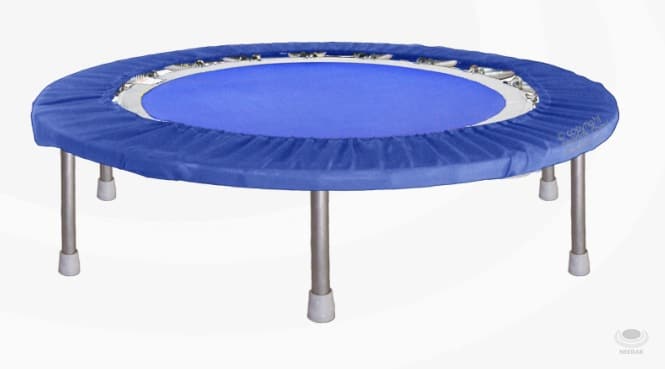Rebounding has lots of benefits, including remedial deadly ailments. But how does rebounding affect cancer? Can rebounding spread cancer? There’s no proof that rebounding is bad for cancer to propagate it. But studies show, rebounding has positive impacts on cancer patients.
Today, I’ll discuss the effects of trampolining on cancer. Let’s have a discussion about how rebounding fight cancer.
Note: This article is for informational purposes only and not medical advice. If you are suffering from cancer, consult with your doctor to decide whether rebounding is suitable for you or not.
Can Rebounding Spread Cancer?
No, rebounding isn’t bad for cancer. Rather than spreading cancer, rebounding is good for fighting against cancer. Jumping on trampolines helps to destroy cancer cells.
As rebounding stimulates lymph flow, hence it will flush the toxic elements from the body through lymph nodes. Not only rebounding, but even the firm message creates positive effects on lymph nodes to heal cancer.
See Also: Cons of rebounding
How Does Rebounding Fight Cancer?
Exercise, including rebounding therapy is good for cancer patients. Here are several benefits of rebounding exercises for preventing cancer.

1. Trampolining Improves Lymphatic Circulation to Stop Spreading Cancer
Toxins are created in our bodies over time that are harmful to us. Environment, food, and even our own metabolism may be the culprits to building different harmful elements, dead or diseased cells, etc, in our bodies.
These toxins can contribute to the growth of tumors and cancer by damaging DNA and other vital molecules in the body. But rebounding detoxifies the body by increasing the circulation of lymphatic fluid, which helps to remove toxins and cancer cells, hence fighting cancer from the body. For that, you should have the right rebounder.
2. Rebounding Develops the Immune System to Heal Cancer
Another key way how rebounding helps to prevent cancer is by boosting the immune system and increasing white blood cells. The immune system is responsible for fighting off infections and diseases, including cancer.
Rebounding helps to stimulate the lymphatic system, which is a network of vessels and organs that help to remove toxins and waste products from the body. By improving the lymphatic system, rebounding can help to boost the immune system and make it better able to fight off cancer cells.
Linda Brooks the author of the book ‘A Simple Approach to Cancer’ claims rebounding is an effective way to boost the immune system and detoxify cancerous tumors. She suggests bouncing on the trampoline as cancer prevention therapy.
3. Bouncing on Trampoline Enhances Oxygen Intake and Circulation to Prevent Cancer
Repetitive jumping on trampolines can improve circulation in the body, which is important for delivering oxygen and nutrients to cells. This increased circulation may help to prevent the development of cancer and also improve outcomes for cancer patients including breast cancer.
Improved circulation can also have other health benefits, such as reducing the risk of heart disease and stroke. It also makes you relax and provides lots of fun.
Rebounding Exercise for Cancer Patients
Cancer patients must consult with their doctors before opting for any exercise, including rebounding. If your therapist recommends rebounding, only then you can do it. However, here are some basic rebounder exercises for cancer healing.
a) Bounce and Stretch
Bounce gently on the trampoline and stretch the arms above the head simultaneously. This kind of bouncing improves lymphatic circulation, while stretching develops flexibility and range of motion.
b) Jump in Place
This is easy to do. Jump lightly on the trampoline while lifting each knee alternately. It helps develop cardiovascular health as well as strengthen leg muscles.
c) Bounce and Jog
This involves bouncing and jogging alternately on the trampoline. It will develop balance and help cleanses toxins from the body hence destroying cancerous cells.
d) Bounce and Squat
It consists of bouncing on the trampoline while squatting down and standing up. This is good for developing leg strength and flexibility.
e) Bounce and Balance
This exercise involves bouncing on one foot while lifting the other foot off the trampoline. This exercise helps to improve balance and coordination.
Recommended Rebounder for Cancer Therapy
It’s important to choose a low-impact bungee rebounder for cancer patients. This won’t create any strain on the joint or knee, as well as detoxify the toxins from the body to heal cancer. Here are several rebounder suggestions for cancer therapy.

- Dave Hall’s Cellercise Rebounder
- Jumpsport Rebounder
- Maximus Pro Rebounder
- Bellicon Rebounder
- Needak Rebounder
We highly recommend, Needak Soft-Bounce Folding Rebounder for cancer therapy.
How Often Should I Use a Rebounder for Cancer Therapy?
Linda Brooks the author of the book ‘Rebounding and Your Immune System’ claims in her book that rebounding two minutes per hour is good for cancer therapy. So, you should bounce on the mini trampoline for approximately 50 minutes per day for cancer prevention.
But if you can’t exercise on rebounders for too long, start with simple exercises for short times like 5 minutes, 10 minutes, etc. And gradually prolong the workout period.
Ending Words
Rebounding exercise can be an effective way to heal cancer. It develops lymphatic drainage, increases oxygen intake and circulation, boosts the immune system, etc, all of which help fight cancer and tumor cells.
But, consult with your doctors first before hopping on the rebounder. And if you get green signals contact a therapy center that provides rebounding therapy for cancer. Hope to hear good news from you regarding rebounding as cancer therapy.

Rebecca is a fitness nerd and mother. She was inspired to get into the world of trampolining and rebounding by her husband Robert, who is a well-respected trainer and expert in the field. Now she instructs children, mothers, and teens the basic trampolining and rebounding tricks.
Rebecca is also a passionate blogger, sharing her knowledge and experiences with others in the hope of encouraging them to give trampolining and rebounding a try.
